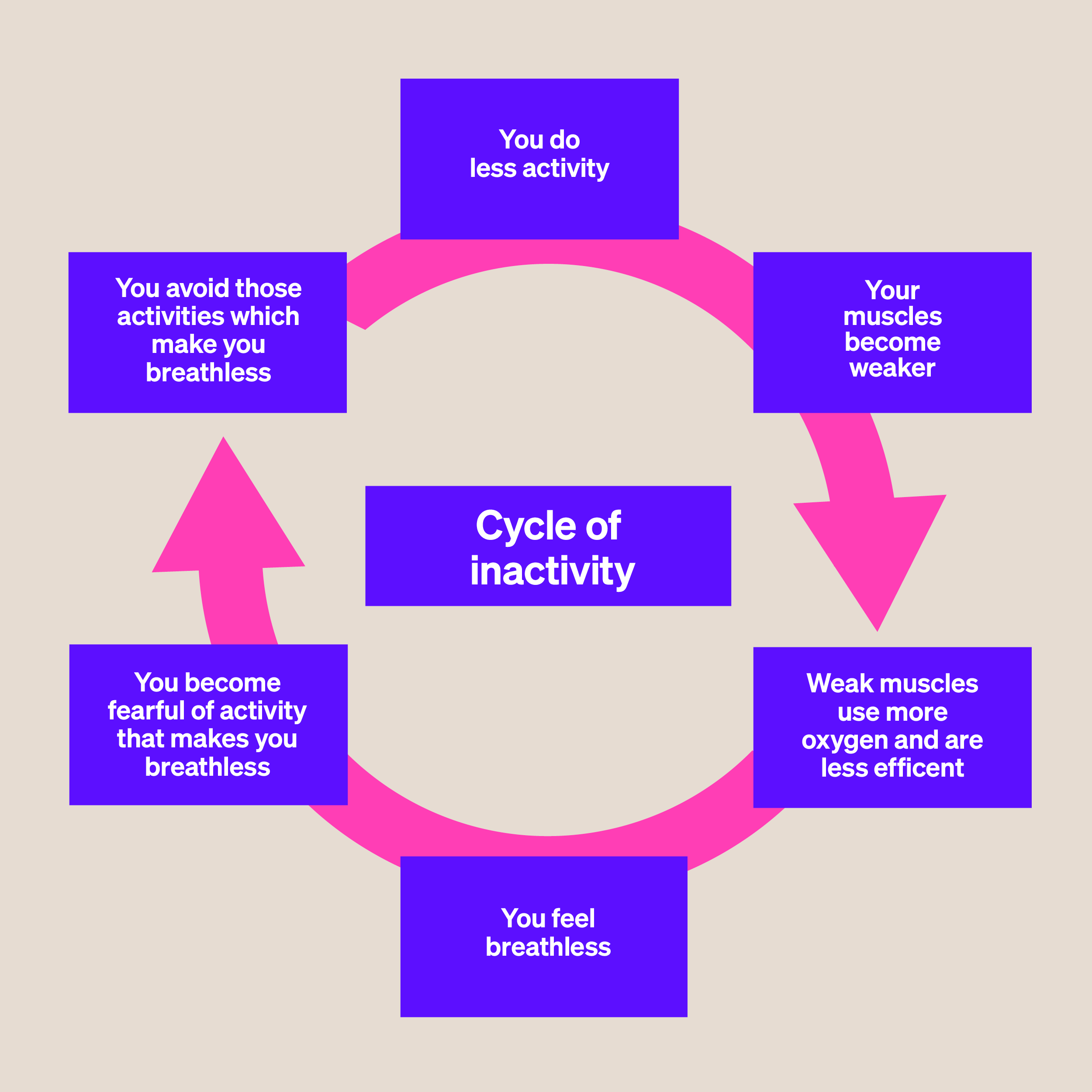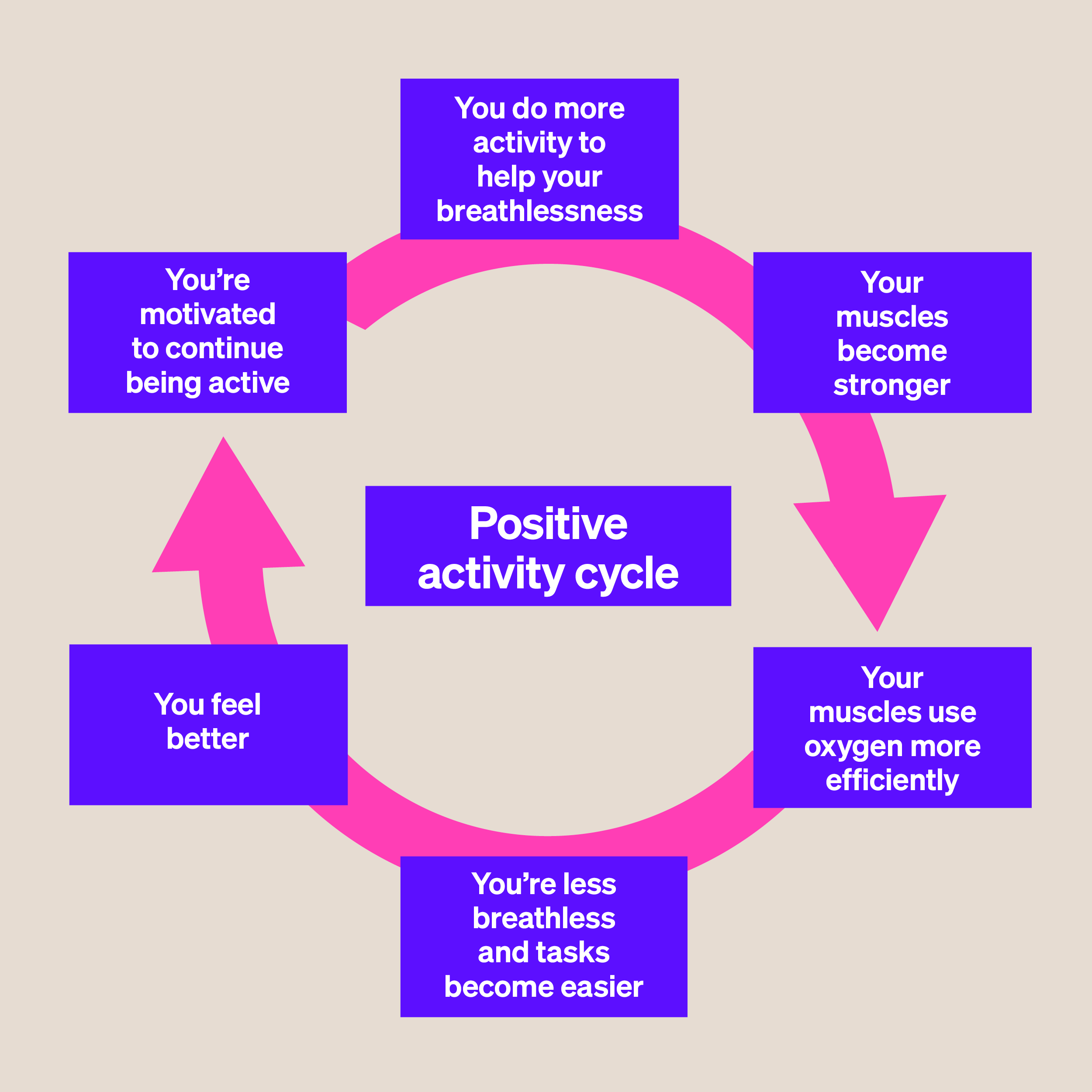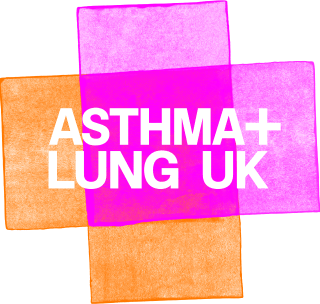Why is movement and exercise good for your lungs?
Regular movement is good for your lungs because it increases the strength of the muscles around your lungs and the rest of your body. As you build strength, your muscles will need less oxygen to work too, meaning you will breathe more efficiently while moving.
If you have a lung condition, being active can help to improve your quality of life and help you manage your condition.
There are many other benefits of physical activity too, it can:
- improve your immune system, helping you to fight colds and flu
- help you to manage and maintain a healthy weight
- lower your stress levels, which can be a trigger for lung conditions like asthma
- reduce anxiety and depression
- strengthen your muscles, helping you to walk further and reduce falls
- help improve your sleep
- improve your brain health, so you can learn and remember more
- reduce your risk of other health problems such as heart disease, stroke, diabetes, osteoarthritis, dementia, and some cancers
- create opportunities to meet new people and feel part of a community.
Getting out of breath
The fear of getting out of breath may put you off doing any activity that makes you more breathless. However, making yourself breathless through exercise can help improve the symptoms of your lung condition.
What happens if I’m not active?
If you avoid activities that make you breathless, your muscles become weaker. Weaker muscles need more oxygen to work. Over time you feel more and more breathless. This is called the cycle of inactivity, or the cycle of breathlessness.

How can being active help my breathing?
The good news is that you can break this cycle of inactivity. By becoming more active you can make your muscles stronger, including your breathing muscles. This will help you feel less out of breath when you do everyday tasks.

How do I cope with being out of breath from exercise?
It’s normal to get out of breath when you’re active, but people with lung conditions tell us that they feel anxious about being breathless. It’s important to stay calm and learn ways to manage your breathlessness. If you panic, it can make you feel even more breathless.
Find out the techniques to help you manage breathlessness.
If exercise triggers your asthma symptoms, it’s usually a sign that your asthma is not as well controlled as it could be. You can lower your risk of symptoms when you exercise by:
- Using your preventer inhaler every day as prescribed
- Seeing your GP or asthma nurse to review your asthma.
For out more about exercise as an asthma trigger.
Call 999 if:
- you’re struggling to breathe or have sudden shortness of breath
- your breathing does not go back to normal after exercise
- your chest feels tight or heavy
- you have pain that spreads to your arms, back, neck and jaw
- you feel sick or are being sick.
What activities and exercises can I do?
You can choose to be active in different ways. You could take part in sports or exercise classes. You can also be more active by changing your daily habits. The main thing is to choose activities you enjoy at the right level for you.
Speak to your GP or healthcare professional for advice before you start exercising. They will advise you on exercise that’s safe for you.
This is to make sure you exercise at a level that’s safe for you and allows your body to get used to moving more.
Try moving more
An easy way to start getting active is to change how much you move during the day and try to move about more than you usually do.
Sitting down less and moving a bit more can make a big difference. If you usually spend a lot of time sitting down, think about ways you can get up and move about more.
You could set yourself goals with achievable steps. When you reach your goals, you can continue to set yourself new goals.
Any movement is good for you and can be part of your daily routines. You could:
- walk about while during TV breaks
- do some housework
- walk your dog
- play with your children or grandchildren
- get off the bus one stop early
- walk to the shops – if you usually drive or get the bus, try walking instead. You can get the bus back if it’s too much.
You could track your steps with tools like a smartphone, smartwatch, or pedometer. Even walking 1,000 more steps a day can help you improve your fitness.
Occupational therapists (OT) and physiotherapists
Your occupational therapist (OT) or physiotherapist can give you some ideas on how to move more. They can give you a plan based on what you want to achieve.
Practising the tasks or exercises suggested by your OT or physiotherapist can help you stay independent, and keep you fit.
Get your heart rate up
Aerobic activities warm up your body, make your heart beat faster, and make you breathe quicker and deeper.
Try to do at least 150 minutes of moderate intensity activity every week. That works out at about 20 minutes a day.
Activities that get your heart rate up include:
- brisk walking
- jogging or running – you could try the couch to 5K challenge, or joining a parkrun
- swimming
- cycling
- playing tennis
- playing football.
Activities like gardening can also get your heart rate up. Weeding, digging or mowing the lawn can improve your breathing and overall fitness. If you find pollen and mould trigger your symptoms, you could take an antihistamine and wear a mask when gardening.
Use the talk test to make sure you’re working at the right level for you.
Strengthen your muscles
Stronger muscles will help you manage your breathlessness. If your body muscles are weak because they’re not used enough, they need more blood flow, which makes your heart and lungs work harder.
Try to do activities that improve your muscle strength at least twice a week. You can fit this into your daily life, for example by:
• carrying shopping bags
• doing yoga
• using weights – you could use cans of soup or bottles of milk
• climbing stairs
• cycling or using an exercise bike.
If you have problems getting out of chairs or are worried about falls, try to strengthen the muscles around your hips and thighs. Climbing stairs and using an exercise bike can help strengthen these muscles.
Improve balance and flexibility
Improving your balance and flexibility will help you to manage aches and pains and improve your posture. Along with strength training, it can also help to reduce the risk of falls in older people. Try to include balance and flexibility activities at least twice a week.
The NHS has a number of exercises to help improve your balance.
Exercise classes and programmes
If you’re not sure where to start with exercising, find out about the different activities you could try:
- Try our movement support course – aimed at people with Long COVID and any other lung condition.
- Download our exercise handbook – try different exercises and record your progress as you go.
- Try the NHS home workout videos – cardio, strengthening and stretching exercises.
- Find out ways to move with We Are Undefeatable – exercising while managing a health condition.
- For more about ways to strengthen your muscles - Stronger My Way has exercises and tips from physiotherapists.
You could also try joining community groups so you can exercise and meet people at the same time:
- Try our Singing for Lung Health classes – for everyone with a lung condition, singing is a great workout for your breathing muscles.
- Join our Feel Good Friday Zumba sessions – designed to be fun, improve mobility and improve your general wellbeing.
- Ask your GP for a referral – they can refer you to an exercise referral scheme or pulmonary rehabilitation.
- Find a local walking group – search the Ramblers website to find a walking group or follow a route.
- Find a local walking sport group – search the Walking Sports website to find clubs near you.
- Find disability inclusive exercise from the Activity Alliance – they have a list of inclusive gyms that you could join.
How much activity should I do?
If possible, you should aim to be active every day. Any activity is better than none.
The NHS has guidance on how much exercise different age groups should do:
If you’re not very active at the moment, you could start with small amounts of movement, and slowly do more. Over time, your ability to move will increase, and you’ll be able to do more.
The talk test
When you’re active, it’s normal to get out of breath, but not too much. You can check if you’re doing the right amount of exercise with the ‘talk test’.
When exercising, say the sentence “this activity is going to do me good!”:
- If you can say the sentence without stopping for breath you can increase the intensity of exercise if you want to.
- If you need to stop for breath when saying the sentence – this is a sign that you’re exercising at the right level for you.
- If you can’t speak or can only say one word at a time when saying the sentence, you need to slow down and find an activity that’s easier for you to do.
Moving safely with a lung condition
It’s important to look after yourself while you’re being active:
- Start slowly and gradually build up the length of time you exercise.
- Warm up before and cool down after your exercise.
- Wear loose, comfortable clothing and supportive non-slip shoes.
- Always have a bottle of water with you when you’re exercising and remember to keep hydrated.
- Wait for at least an hour after eating before starting to exercise.
- Have your reliever inhaler with you when you exercise if you use one.
- If you normally use oxygen, even for just some of the time or overnight, speak to your respiratory nurse about what setting you should be using.
- Be active at a level that’s right for you – use the talk test to check.
Get to know your personal triggers like pollen, dust or heat, so you can plan your exercise to avoid them.
STOP exercising if you get any sudden symptoms, such as:
- chest pain or tightness
- feeling dizzy, nauseous, clammy, or cold
- feeling increasingly wheezy
- getting sore joints or muscle weakness.

Get support
Call our Helpline for support with your condition. Get advice on your medicines, symptoms or travelling with a lung condition, or just call us to say hello.




